

By
Don and Linda Freedman
Search TheTravelzine
TheTravelzine Group
Access Your Mail
Don's Gallery
Packing Hints
Planning Tips
Cities Links
Links
LINKS TO OUR TRAVELOGUES
Argentina, Buenos Aires - Jan-Mar 2010
Argentina, Buenos Aires - Jan-Mar 2009
Argentina, Buenos Aires - Jan-Mar 2008
Austria - Fall 2005
Belgium, Brussels - Fall 2000
Canada - Summer 2002
Canada - Summer 2001
Canada - Summer 2000
Czech Republic - Spring 2000
France - Fall 2002
France, Paris - Fall 2000
France, Paris - Spring 1999
France, Lyon - Spring 1999
Germany, Berlin - Fall 2009
Germany - Fall 2002
Germany - Spring 2000
Germany - Fall 1999
Greece - Fall 2012
Greece - Fall 1999
Greece - Fall 1997
Hungary - Spring 2000
Israel - Fall 1999
Italy - Winter 2007
Italy - Winter 2006
Italy - Winter 2005
Italy - Winter 2004
Italy - Winter 2003
Italy - Winter 2001
Italy - Fall 1998
Italy - Fall 1996
Netherlands - Spring 2000
Portugal, Azores - 2019
Portugal, Azores - 2018
Portugal, Sao Miguel & Lisbon - 2017
Portugal, Azores - 2017
Portugal, Azores - 2016
Portugal, Azores - 2015
Portugal, Azores - 2014
Portugal, Azores - 2013
Portugal, Azores - 2012
Portugal, Azores - 2011
Portugal, Lisbon - 2011
Portugal - Fall 2006
Portugal - Fall 2004
Portugal - Fall 2003
Portugal - Fall 2001
Portugal - Spring 1999
Portugal - Spring 1997
Slovakia - Spring 2000
Slovenia - Spring 1999
Slovenia - Fall 1996
Spain, Barcelona - Winter 2006
Switzerland - Fall 2002
Switzerland - Spring 2000
Switzerland - Spring 1999
Switzerland - Fall 1998
Switzerland - Fall 1997
Switzerland - Spring 1996
U.S. Florida, Key West - Fall 2006
U.S. Florida - Spring 2001
U.S. Maine - Summer 2002
U.S. Massachusetts - Summer 2003
U.S. Massachusetts - Summer 2002
U.S. Massachusetts - Summer 2001
U.S. New York State - Fall 2005
U.S. New York State - Summer 2004
U.S. New York State - Summer 2003
U.S. New York State - Summer 2001
U.S. Washington,DC - Spring 2000
ITALY
WINTER 2007
MARINA DI
CASTAGNETO CARDUCCI | PISA | FIRENZE | AREZZO
CORTONA | PERUGIA | FOLIGNO | TERNI
ORVIETO | ROMA
AREZZO
The Province of Arezzo, located in the easternmost part of Tuscany, is one of Tuscany’s best kept secrets.
The north-eastern part of the province is mountainous with four valleys; Valdichiana, Valtiberina, Valdarno and Casentino and two rivers (Arno and Tevere). We were about to discover why this area should become part of a visit to Tuscany.
The low hills of the western part of the province are covered with grape and olive groves while the lowlands of the south bathe in sunshine.
The city of Arezzo is situated on a hill that rises gently in a fan shape from the city gates to its highest point. As you ascend it goes from its more modern era to its ancient medieval beginnings at the peak where the Cathedral, City Palace and Medici Fortress are surrounded by trees and parks.
The stazione (train station) is just outside the gates. Straight ahead is the Corso Italia, the wide main street that runs up through the center of the fan all the way to the top of the hill.
We walked up Via Madonna del Prato, which runs parallel to Italia, and becomes Via di S. Francisco and then Via A. Cesalpino which throughway is the other main artery to the top.
As we approached Via Cavour at its
intersection with Via S. Francisco, we had to carefully
weave our way around the corner through the crowd. It was
the first Sunday of the month when Arezzo hosts its
famous Antique Fair. From its center in the nearby Piazza
Grande (also known as Piazza Vasari), the antique fair
spills onto the surrounding streets and squares. 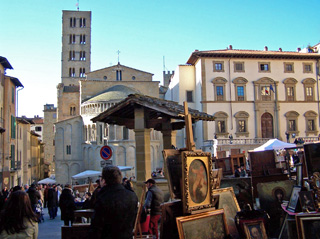
This is no ordinary street fair; this is a serious historical event with offerings for average shoppers and professional dealers alike. Sundays are usually very quiet days for visitors in any city but this is an exception. Plan to stay in Arezzo the weekend of the first Sunday of the month.
Our destination was Via Cavour, 23, The Hotel Patio, a transformed historical palace, which is perfectly located in the center of the city. The large entryway leads to the reception area where the owner and her staff welcome their guests. A wide stairway leads to the seven rooms and suites which surround an atrium. There is no elevator but the staff will gladly carry your luggage to your room.
Each room and suite is dedicated to
one of Bruce Chatwin's famous books and decorated with
original furniture and furnishings from the country it
represents. Ours was "Ouidah", from "The
Viceroy of Ouidah", a short story of tropical
madness and cruelty. The Viceroy’s nickname was
"The Elephant" so the frame of the large wall
mirror is decorated with small elephant heads. A wooden,
beamed ceiling, a bed with a wrought iron headboard,
wicker tables and chairs, a wooden armoire, walls painted
bright yellow and cherry red with bedding and drapes to
match, and a combination of old lighting fixtures mounted
on carved wood plaques and modern wall spot lights
completes the funky decoration. The golden bathroom was a
good size with a stall shower. Both the bedroom and
bathroom had windows opening to the atrium. A very good
breakfast buffet is served in the charming ancient cellar.
[Back
to Top]
Arezzo’s Antique Fair, the first of its kind in Italy, was founded in 1968 by antique dealer Ivan Bruschi who had the passion to unite his love for antiques with his town of Arezzo. His devotion to his profession and chosen cause led to Arezzo and the region becoming a well-known destination for antiques of all kinds, an economic success story.
One of Arezzo's most elegant 13th
century civil buildings, Palazzo del Capitano del Popolo,
at Corso Italia, 14, where Ivan Bruschi lived and worked,
was beautifully restored to house his prized possessions.
He established the Ivan Bruschi Foundation to fund his
legacy. La Casa Museo di Ivan
Bruschi, now open to the
public, is another significant reason to visit Arezzo.
This extraordinary collection of archaeological treasures,
jewels, ceramics, paintings, furniture, glassware,
weapons, books, porcelains, ivory, etc., is lovingly
presented on three floors. We were captivated by Bruschi's
vision, just as he would have wanted. 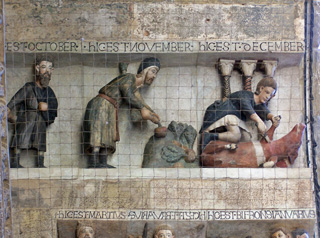
Across the street from Casa Museo Bruschi is the parish church Santa Maria della Pieve, the largest Romanesque church in the Arezzo region. Its 60m tower "of one hundred holes" (because of its double mullioned windows) is one of emblems of the city. Under the front arch is the marvelously preserved full color sculpture, "cycle of months", worth craning your neck to see. In contrast to the sumptuous decoration of the facade the interior is quite stark.
Corso Italia was packed with folks hauling their antique acquisitions, shoppers who preferred new fashion to old stuff, gelato lovers and folks like us, taking it all in and exploring the streets and squares appreciating the city design and architecture. It's a terrific walking city with surprises around every corner.
Via Cavour, which runs through Piazza S. Francisco, is the main cross street through the center of the city. Piero della Francesca's brilliant frescoes “Leggenda della Vera Croce” (Legend of the True Cross) are in the church of S. Francisco. This piazza is immortalized in the film "Life is Beautiful".
We headed to the lower part of town to visit the Anfiteatro Romano (Roman Amphitheatre) and Archeological Museum at Via Margaritone. Enough remains of the amphitheatre to visualize what it had been even if much of the original stonework was taken to build the Cathedral. In the summer it becomes a venue for concerts.
The Archeological Museum, in a
former convent, contains marvelous collections of gold
jewelry, 6th century Etruscan terracotta and bronze work,
the famous "coralline vases" made in the local
red vase factories with the insignias of the
manufacturers, mosaic sections of floors and pavements,
sculptures, remains from tombs, ceramics, weapons, with
private collections in separate rooms.
[Back
to Top]
Arezzo once had a thriving gold
manufacturing industry employing about 1000 workers in a
few establishments but the business became more
fragmented as employees left and started their own
businesses. 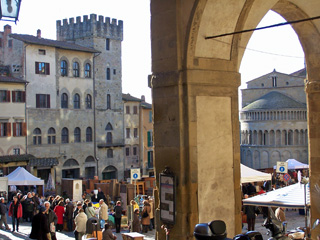
Behind S. Maria is Piazza Grande, the heart of the city, surrounded by a compilation of architectural styles, Romanesque, Gothic, renaissance and baroque. The Gothic and renaissance facade of the Palazzo della Fraternita, the 18th century Palazzo del Tribunale and the 16th century Logge del Vasari are joined by two noblemen's tower houses of the 14th century and ordinary 13th century houses bringing harmony to the great square. It's particularly famous for hosting the "Giostra del Saracino" (joust of the Saracen) on the third Sunday of June and the first Sunday of September every year.
It was late in the day as we made
our way to the Duomo, the bold Gothic Cathedral at the
summit. Particularly significant are the striking stained
glass windows by Guglielmo de Marcillat and Piero della
Francesca's "Magdalen". 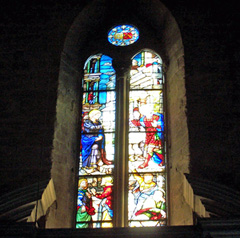
We found our way to Piaggia S. Martino 8, just off Piazza Grande, La Torre di Gnicche, an enoteca and restaurant. It's a 7 table wine bar with typical local food offerings. After a day of walking it was a delight to sip some light fruity house rosso and nibble on fette croccanti, one with melted scamorza another topped with pomodoro and funghi. This was followed by two marvelous soups. Pappa con pomodoro, thick and rich with tomato, onion, garlic, olive oil and sage (basil is substituted in the summer) and traditional ribollita was as good as this favorite gets.
The two mains of polpettone (meat loaf) al vino rosso and maiale arrosto con patate were somewhat disappointing after the exceptional soups but very good ricotta and pear tarte was a nice finish. Stick with cheeses, meats and soups and you will be well served.
If you’re planning to be in
the vicinity between March 31 and July 22, 2007 you
should get to Arezzo to see the exhibition, "The
Majesty of Piero: Piero della Francesca and the Italian
Courts”. Over 100 15th century masterpieces will be
displayed including the works of Piero della Francesca
and other great artists of the time. Arezzo is an
endearing city to explore.
[Back
to Top]
Speaking of exploring, today we were off to do just that in the valley and mountains of nearby Casentino.
We had met a well known artist and writer, Giovanni Caselli in Toronto last fall and he had invited us to spend a day with him to get a taste of The Casentino where he resides. He has written and illustrated a wonderful book, "Casentino, Its History and Environment in 58 Walks”.
Train tickets for the private line that runs to the Casentino region are sold at the Tabacchi in the stazione, not at the regular train windows. It was a 44 minute ride to Bibbiena, the administrative center of the Casentino, where we met Giovanni and his friend Alessandro De Vivo, the artist.
There are no major highways to disturb the beauty and tranquility, just good local roads that wind around the mountains and through the valley. It did not take us long to appreciate why the Casentino has always been an inspiration for artists with its mountain landscape dressed in thick forests of beech and chestnut trees. Agriculture, particularly grains and pig farming, is the main industry.
This environment has led to a growing network of agriturismi. We stopped at one such farm, Fattoria Corsignano, a magnificent property, surrounded by mountain views, lush landscapes, attractive stone buildings for lodging, restaurants, meeting and banquette halls with patios, pools, and lounging areas and room to roam.
We headed to the land of Michelangelo's birth. In 1913 a royal decree established that he was born in Caprese, but for centuries before it was believed that he was born in the Castle of Chiusi, some 12km away, where Lodovico, his father, was residing at the time of his birth.
The village of Chiusi della Verna sits on high between Casentino and Valtiberina. In August 1995 the European Cultural Association "Michelangelo" completed the first stage in restoring the 12th century building which was the seat of the Potestery (Mayor) of Chiusi della Verna and of the law court. The restoration is now much more complete thanks to efforts of our guide Alessandro De Vivo and his wife Mara. When finished the Potestery will be a cultural center.
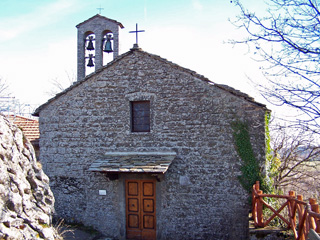 The Potestery is
next to the Castle of Count Orlando Cattani who allowed
St. Francis of Assisi to settle here in 1213. In 1300 a
small church was built and named St. Michael Archangel.
It was established to honor the then local PodestÓ of
the Florentine Republic, Lodovico Buonarroti. When his
son was born he was baptized "Michelangelo" in
the church.
The Potestery is
next to the Castle of Count Orlando Cattani who allowed
St. Francis of Assisi to settle here in 1213. In 1300 a
small church was built and named St. Michael Archangel.
It was established to honor the then local PodestÓ of
the Florentine Republic, Lodovico Buonarroti. When his
son was born he was baptized "Michelangelo" in
the church.
The fact that Mount La Verna was represented in Michelangelo's “Tondo Doni”, the Crucifixion of St. Peter, the Conversion of St. Paul established a link between the artist and this place. Further, he represented Adam about to receive the Divine sparkle lying on the very rock next to the house in which his father resided when the artist was born. Wanting to depict "earthly paradise", Michelangelo drew his inspiration from this place and for this reason his Adam's Rock and Mount La Verna are seen in the central arc of the Sistine Chapel. The news of the discovery of the view from the rock became official on Oct. 2, 2004 and in the summer of 2005 the exact view was found to be obtainable from right in front of the Potestery.
It was a cultural and artistic inspiration to experience the view and the feeling of being in the place where the great Michaelangelo lived and worked. To top it off we were invited to have lunch in the Antica Podesteria (Ancient Potestery) prepared by the lovely and talented Mara De Vivo who besides proving she knew her way around the cucina, entertained us with her delightful singing.
The Art and Tourism Association offers 20 itineraries and customized tours to discover the region and the life of Michelangelo. Lunch at the Potestery is usually included which will allow you to feast, as we did, on the likes of crostini with cheese and funghi and sausage, hand made gnocchi with ragu, fallow and red deer stews, polenta and dolce with Vin Santo.
Other useful websites:
http://www.michelangelo.it
http://www.podesteriadichiusi.it
http://www.alessandrodevivo.it
After overnighting in Arezzo, we
were off to Cortona in the morning.
[Back
to Top]
MARINA DI
CASTAGNETO CARDUCCI | PISA | FIRENZE | AREZZO
CORTONA | PERUGIA | FOLIGNO | TERNI
ORVIETO | ROMA
Search TheTravelzine | TheTravelzine Group | Don's Gallery
Packing Hints | Planning
Tips | Cities
Links
All pages on TheTravelzine.comęCopyright 1996-2020 Don & Linda Freedman